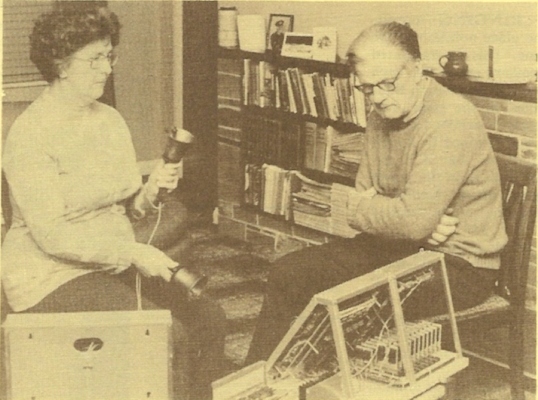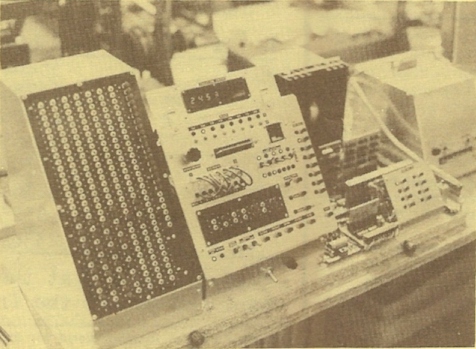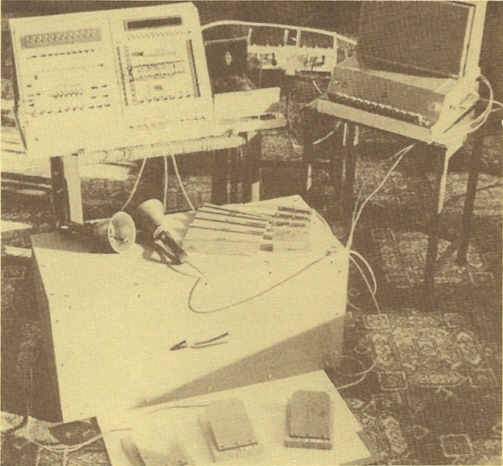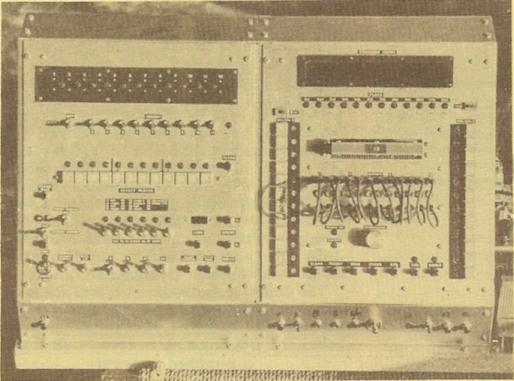 |
The mechanical generation of change-ringing sequences was first achieved many years ago, the best known example being, perhaps, the machine made by John Carter. The problems involved are challenging and result in enormous labour and complication. The evolution of the science of electronics has made possible the solution of these problems much more readily and with a higher degree of sophistication. I would like to tell the story of my own experiments in electronic change ringing, and of how a project which started purely as an exercise in applied electronics developed into a practical learning and teaching aid, particularly in the case of handbell ringing.
The project started early in 1977 and resulted in a design which proved subsequently to have been developed along the wrong lines, although it worked, at least as far as being able to ring extents of Plain Bob Minor. For this I had “hardware” programmes in the form of plug-in modules each containing the information in a complete lead of the method. This was done by generating sequences of blows corresponding to the separate segments of the “blue line”, one of each of which is contained in one lead. At the lead end these were cycled around relative to the bells so that, for instance, what number two did last time, number three would do next. Bobs and singles were inserted by transposing the coursing order at the lead ends. It was intended originally to make this system capable of ringing Major methods, but with the programme space available this would have been limited to plain methods and the amount of hardware would have been prohibitive. This model was abandoned at this stage, but nevertheless much useful experience had been gained.
The original ringing unit, which is still operational, consists of eight clock chime rods tuned to an octave, and struck by solenoid operated hammers which are driven vertically upwards and strike the rods from underneath. They fall back by gravity onto foam pads, so that the actual striking mechanism is quite silent. The sounds produced are quite pleasant, and it is interesting to watch the strikers tracing out the pattern of blows. This ringing unit has now been replaced by another one which is completely electronic, and which will be described later in more detail.
 |
For the model, which I now call the Mark II, I adopted a fundamentally different approach and developed what is, in effect, the electronic equivalent of the Woodhouse machine. In this the changes are generated one row at a time by “swopping” pairs of bells. The method is programmed on a plug panel, or pegboard, by converting the place notation into “swops” between pairs of bells in each row of one complete lead of the method. There are thirty-two rows of seven swops available, so that any method up to Surprise or Treble Bob Major can be rung. The programme is scanned vertically from top to bottom by a counter which is preset to the number of rows in a lead of the method, and which is stepped on one place just after the completion of each row. The swops required for the next change are then passed to the transposition unit, which is equivalent to the “distributor” in the Woodhouse machine, and which directs the blows to the bells in the new order. The last row of the programme is always the lead end row, and if a bob or single is required it is selected about one “whole pull” earlier by the appropriate push-button. The lead end change is then switched to an auxiliary plug panel on which the bob and single changes for the method have been set up. The call is cleared automatically at the lead end, and plain courses based on the new coursing order are rung until the next call is made. Touches of any length can be rung by putting in calls as required just as in the tower.
 |
The clock which decides the ringing rate can be set to give a continuous variation from about one blow per second to sixty rounds per minute. It can be inhibited at any time which will “freeze” the system as it was at that instant, and will continue the sequence undisturbed when reactivated. This is a very useful facility when a discussion has to be held concerning what dodge a particular bell will make next.
Provision is made for selecting any two bells for observation by means of push-buttons. Two rows of miniature lamps, one red and one green, then show the places in which the observation bells are striking. The lamp lights at the moment of striking the blow and remains alight for the interval between that blow and the next. This gives a visual indication of the “blue line” being rung. By this means also, operations such as coursing pairs, mutual dodging and place making can be very effectively demonstrated.
NUMERICAL DISPLAY
Another very useful feature is a coursing order indicator. This gives a numerical display of the order in which the bells are coming down to lead at any time. It remains static for the duration of any one lead, and is updated at the lead end. With this it is possible to learn conducting by coursing order, as all the information required is contained in the display. By the time the Mark II was complete I had learned quite a lot about method construction and conducting, and eventually rang several quarter peals in various methods by memorising the sequences of calls.
The project had now proved so successful that I started the design of the Mark III, which was to be capable of ringing on twelve bells, and which would require a new ringing unit. Here I began making experiments in the electronic synthesis of bell sounds, in which I received invaluable help from Dr. John Baldwin of Cardiff University. He and his colleagues had made analyses of the sounds of a light ring of six bells at Llantarnam, near Cardiff, and it was upon these that I modelled the back six of my new ring of twelve. Much useful information was also obtained from a series of articles published in “Hi-Fi News” some years ago (1). In the new ringing unit the sound of each of the twelve “bells” is synthesised by adding together electronically-generated tones of seven harmonically related frequencies. These tones are arranged in three groups each with a different decay time, and the resulting sounds are very realistic and pleasant to listen to.
The design of the Mark III is very similar to that of its predecessor, having the same operating controls and displays, but extended to ring twelve bells. The programming is entirely electronic, and is done by entering the place notation of the method one row at a time. This is translated electronically into the necessary swops for each row of a plain lead and stored in a memory. Bobs and singles are programmed in the same way. When the main power supply is switched off the information in the memory is retained by means of a small stand-by battery, so that it is not necessary to re-programme each time the power is switched on. A manual count facility is provided so that the programme can be checked at any time.
At about the time the Mark III was nearing completion I started to think of ways in which the “machine” could be put to some practical use. It was very interesting and instructive to set up various methods and hear them rung, and dodges are never missed! But this seemed to be all that could be done, and it did tend to become monotonous.
 |
The electronic ringing unit has a set of manual keys by which individual “bells” can be struck, quite independently of the change unit. The latter is arranged so that any bell or bells can be very easily disconnected, to be struck instead by the key. In this way I found it possible to learn the rhythmic patterns involved in ringing two bells in various change sequences, and after a few hours’ practice had learned the three “positions” involved in ringing two bells to Plain Bob Minor. The only disadvantage in this way of learning was that the physical movements required were unnatural, consisting only of pressing two keys with the fingers. This could be with two fingers of one hand or with one finger of each. I then started to think about some way of simulating the action of a pair of handbells, with electrical switches which could be connected to the ringing unit. The solution proved to be very simple and completely effective, namely - a pair of handbells! The Whitechapel Bellfoundry were very helpful and let me have a pair of old but serviceable bells which were very easily modified for the purpose. I removed the strikers from the clappers and fitted very simple adjustable contacts which were operated by the buffer springs. A couple of yards of thin flexible cable to plug into the ringing unit completed the modification. The “feel” of the bells is not altered in any way, and the electrical contact is made at the same time as that at which the clapper would have struck the bell originally. This is most important, and together with the freedom of movement enables the bells to be rung in a completely natural manner.
With continuing practice I was now able to prove that it is possible to learn change ringing with handbells correctly and accurately by this means. The rhythmic accompaniment provided by the “machine” is precise, if somewhat ruthless, but I have found that this is not a serious disadvantage, as it has the effect of forcing the pace provided that one has enough patience to persevere. It must also be appreciated that the process is entirely aural, and it is necessary to listen and count continually. The only visual information available is that provided by the place indicator lamps, and that is unrealistic. On the other hand the ability to ring entirely by ear and rhythm means that any visual information provided later when ringing with other people is a bonus.
To extend the utility of the simulator, as I should now call it, I have fitted a set of three foot-operated switches which enable the transition to be made from rounds to method and back, and also bobs and singles to be inserted at will, and without interrupting the ringing. With this facility one is completely independent of other people and touches of any length can be rung.
As an aid to tower bell ringing the system is of much less use, although the “blue line” of a method can be practised by ringing one bell. In the case of odd-bell methods, however, ringing the tenors is very good practice, both for handbell ringing and for learning a “blue line”.
The success of the experiment was finally proved when I succeeded at the first attempt in ringing a course of Plain Bob Major with three other ringers.
Reference 1. H. M. Howard. “Hi-Fi News” Vol. 2 1957 pp. 66, 102, 152, 227, 274.
P. A. Cummins.
 |
The Ringing World, June 29, 1979, pages 559 to 560